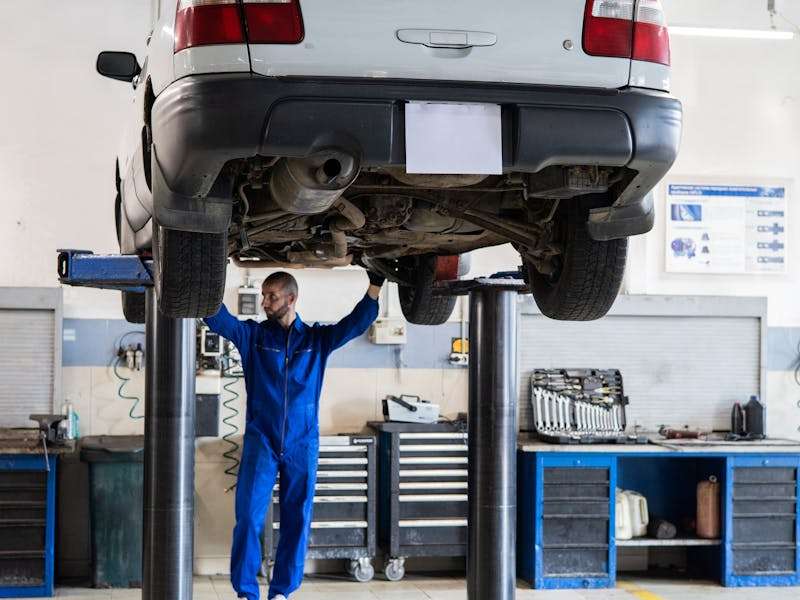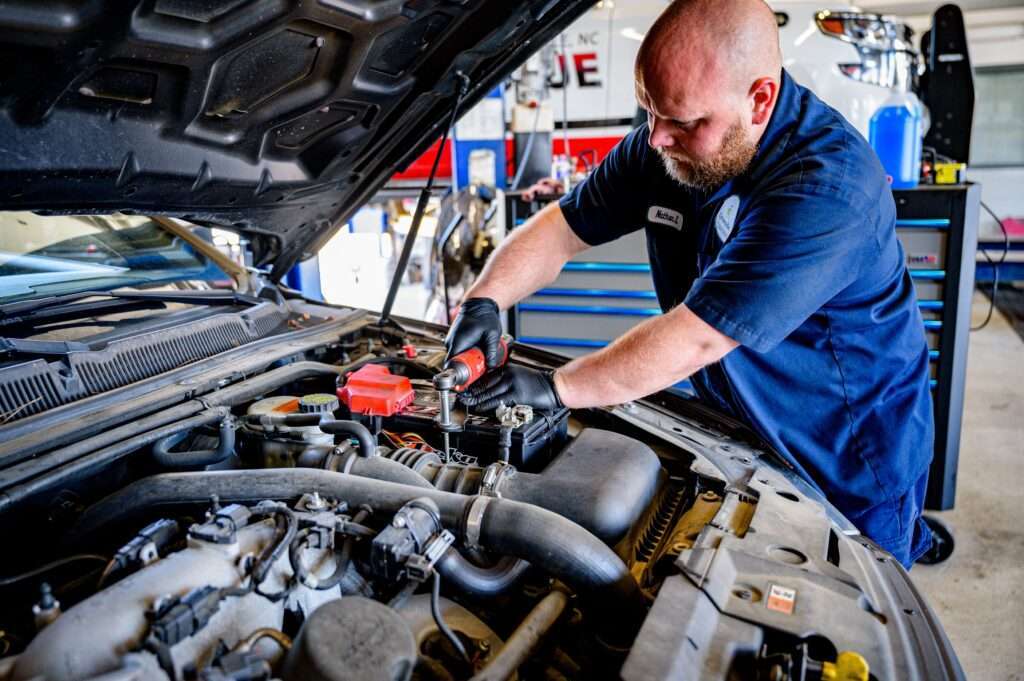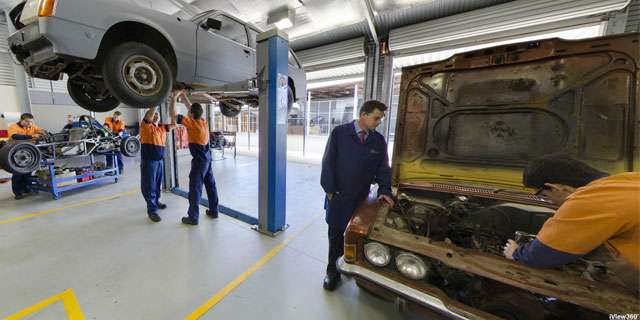Ignoring the manufacturer’s service schedule, lacking knowledge of what is included in a full car service and forgetting to mention specific problems are some of the common mistakes for first timers.
A full car service is a comprehensive check-up of your vehicle to ensure that every essential component is in proper working condition. It goes beyond a basic or interim service.
Meaning that a full car service covers a wide range of checks, replacements, and maintenance tasks to keep your car running efficiently and safely. Servicing a car is a process that has the potential of saving you some extra costs which may be a result of accumulating car problems.
This is possible because it helps to identify issues in advance. In fact, performing car service will also save you from the potential of accidents occurring due to mechanical issues. For example, brakes failure.
What is a full car service?
A full car service is meant to check the car’s condition by assessing the general wear and tear, fluids, brakes, the engine and much more. The car maintenance schedule is either time or mileage based.
Regular maintenance is one way of reducing the total car service costs. Specific areas like the fluids require regular car service to ensure they’re available in sufficient amounts.
Further, ensure there is no fluid leakage by checking whether there is a colorful fluid under the car. This will help to prevent incidents that stem from insufficient engine fluids.
The difference between full and interim services.
While an interim service focuses on basic checks like oil and filter changes, a full car service is much more detailed. An interim service is typically recommended every 6 months or 6,000 miles, whereas a full service is performed annually or after 12,000 miles.
The full service covers additional elements like brake inspections, suspension checks, and detailed assessments of the engine and exhaust systems.
What does a full car service include?
A full car service includes, fluid checks like engine oil, tire checks, inspection of suspension and steering systems, exhaust system checks and brake checks.
Some of the items in this full car service checklist require replacement while others won’t need to be replaced. These are all the essentials that need to be verified during the servicing.
A full car service involves more than 50 checks and actions, depending on the make and model of your vehicle.
- Engine oil change and oil filter replacement
- Brake fluid level check and top-up
- Air filter replacement
- Battery health check
- Suspension and steering system inspection
- Brake inspection, including pads, discs, and calipers
- Tire condition and pressure check
- Exhaust system examination
- Lights, wipers, and horn functionality tests
- Cooling system check, including antifreeze levels
By ensuring all these components are in good working order, a full car service helps maintain the safety, reliability, and longevity of your vehicle.
What to expect during a full car service.
When you take your vehicle in for a full car service, you can expect a thorough examination of all major systems and components. The service provider will undertake steering system checks, brake system checks, suspension system checks, engine oil checks and other fluids.
(a). Engine oil checks and other fluids.
One of the first tasks during a full service is an oil change. Fresh engine oil reduces friction, ensures smooth operation, and prevents engine wear. The oil filter is also replaced to ensure that contaminants don’t circulate within the engine.
In addition to oil, mechanics will inspect other essential fluids, including brake fluid, transmission fluid, power steering fluid, and coolant. Any necessary top-ups or replacements will be made.
(b). Brake system and fluid checks.
Your vehicle’s braking system is one of the most important safety features. During a full service, mechanics will thoroughly inspect the brake pads, discs, calipers, and brake fluid levels. If any components show signs of excessive wear, they will be replaced to ensure safe braking performance.
(c). Suspension and steering system inspection.
The suspension and steering system directly affect handling and ride comfort. During the full car service, mechanics will check for any damage to the suspension system, including the shock absorbers, struts, and ball joints. They will also assess the steering system to ensure smooth and precise control of the vehicle.
(d). Battery and electrical system evaluation.
The health of your car’s battery is critical for reliable starting and powering electrical systems. During the service, mechanics will test the battery’s voltage and charging capacity. They’ll also inspect your vehicle’s lights, wipers, horn, and other electrical components to ensure they are functioning properly.
(e). Exhaust system and tire checks.
The exhaust system will be checked for leaks, blockages, or damage, ensuring it complies with emission standards. Tires will also be inspected for tread wear and pressure, which are essential for safety and fuel efficiency.
Why & when should you get a full car service?

Benefits of the car service, signs that your vehicle needs a full service and the effect of mileage/time on the service schedule, are the determinants of why & when you should get a full car service. Knowing when to schedule a full car service can prevent costly breakdowns and ensure your vehicle is always in top condition.
When should you get a full car service?
The question of when you should get a full car service can be answered by considering the recommended full car service intervals and the signs which indicate that your vehicle needs a full service.
1. Recommended full car service intervals.
Most car manufacturers recommend getting a full car service once a year or every 12,000 miles, whichever comes first. This frequency ensures that your vehicle is regularly checked for potential issues that could develop into more severe problems if left unaddressed.
However, the interval can vary depending on the make, model, and usage of your car. For vehicles that see heavy use, such as taxis or delivery vehicles, more frequent servicing may be required to keep them operating reliably.
2. Signs your vehicle needs a full service sooner.
Unusual noises, dashboard warning lights, poor handling and reduced fuel efficiency are some of the signs your vehicle needs a full service sooner. Sometimes, you may need a full car service sooner than the manufacturer’s recommended interval.
(a). Unusual noises.
Clunking, grinding, or squealing sounds can indicate problems with your car’s brakes, suspension, or other critical components.
(b). Dashboard warning lights.
If the check engine dashboard warning light or other warning lights come on, it’s time for a full inspection.
(c). Poor handling or braking.
If your car feels sluggish when accelerating or braking, or if the steering feels loose, it’s a sign you need a full car service.
(d). Decreased fuel efficiency.
A noticeable drop in fuel efficiency could mean that your car is not running as efficiently as it should, which is something a full service can address.
3. Does mileage or time matter more for full car services?
Both mileage and time play a role in determining when to get a full service. Even if you don’t drive often, components like engine oil, brake fluid, and rubber seals degrade over time. Therefore, if you reach a year of ownership without hitting the mileage mark, it’s still important to get a full service to maintain your car’s health.
Why do I need car service.
The reasons why you need car service include to reduce total fuel costs, for a better car resale value, for an improved car lifespan and long-term cost savings. These are the advantages of undertaking a full car service.
- To reduce total fuel costs.
The fact that the car service includes checking the fuel pump is a guarantee of better fuel consumption. Additionally, the tuning of the throttle body is a sure way to ensure efficient fuel utilization. If you notice that your car is using more fuel for lesser distance, it’s important for you to consider a service checkup.
- Better car resale value.
A well maintained car alongside a tuned car will be of a higher resale value. In comparison to a car that hasn’t undergone regular maintenance servicing. That’s because a serviced car comes with better operating system.
- Insurance cover premiums.
Insurance companies will usually assess your service schedule before they reimburse your cover. Especially after an incident that requires the insurance company to intervene. Further, depending on the insurance company’s policies, undertaking regular servicing will save some insurance costs.
- Improved car lifespan.
It is obvious that regular car servicing will largely affect the vehicle’s lifespan. By vehicle lifespan we mean the duration before some mechanical issue makes your car to brake down.
- Long term cost saving.
By undertaking regular servicing, you will avoid costly breakdowns that could occur in the long run due to continued malfunctions. Incase something brakes-down due to neglect, it will cost you a lot more. This is in terms of replacement or repair fee as well as time and convenience costs.
Why a full car service is important.
A full car service is important because it extends the lifespan of your vehicle, ensures safety and reliability on the road and it maintains vehicle value for resale. Regular full car services keep your vehicle running smoothly, safely, and efficiently.
(a). Extending the lifespan of your vehicle.
Routine servicing helps extend the life of your car by ensuring that minor issues are detected and fixed before they become major problems. Replacing worn components, keeping fluids topped up, and maintaining proper tire pressure all contribute to prolonging the longevity of your vehicle’s engine, transmission, and other vital systems.
(b). Ensuring safety and reliability on the road.
A full car service ensures that your brakes, steering, tires, and suspension are all in good working order, helping to avoid potential accidents caused by mechanical failure. By catching problems early, you’ll have peace of mind knowing that your vehicle is reliable and safe to drive, especially on long journeys or in difficult weather conditions.
(c). Maintaining vehicle value for resale.
Regular full car services also help maintain the resale value of your vehicle. When it’s time to sell or trade in your car, a well-documented service history can boost its value. Buyers are more likely to purchase a car that has been regularly serviced and maintained, as it signals that the vehicle is less likely to have hidden mechanical issues.
In addition, a well-maintained car is less likely to experience major breakdowns or repairs, saving you money in the long run.
DIY requirements for servicing my car.

Many car owners may view the task of servicing the car as a really technical occurrence. But if you have the right tools as well as the knowhow, this isn’t far fetched.
There are a number of things that you can do by yourself in terms of servicing the car. On the contrary, there are issues that you shouldn’t handle without the technical knowhow.
1. DIY car servicing and maintenance.
The following are some car maintenance routines that you can undertake by yourself. They will go a long way in helping to reduce the risk of car breakdown. Further saving you a lot of costs that are associated with car breakdowns.
(a). Checking oil levels.
Car oil is an essential part of the engine in terms of lubrication and cooling. You can personally check the oil levels within the engine block without any technical knowhow.
If the oil has been present over an essential amount of miles, it’s important for you to drain the oil tank and add new oil.
(b). Tires.
There are a number of things that you can do for the car’s tires to ensure they are in good driving conditions. This won’t involve the utilization of a professional’s input.
But the outcome of this DIY exercise will require the input of a professional. For example, tire balancing and alignment will require a professional who has the required equipment.
The best you can do in terms of DIY car servicing for the tires is to check the tire thread’s breadth, tire pressure and condition.
(c). Oil and engine fluid levels.
This is one of the easiest parts of the car service checklist. You just need to ensure that there is no leakage of the car’s engine fluid components. Inclusive of oil, coolant, brake fluid, power steering fluid, water among others. Incase there is a deficit in those fluids, then you can top up.
(d). Handbrake.
The handbrake is also called the parking brake. Some cars will usually have a problem with parking on a steep slope.
That’s because the parking brake may be experiencing some problems. Ensure you look into how effective it is at holding the car in place. Conduct parking on a steep surface test.
(e). Air filter.
Air filter replacement is a DIY task. As long as you know what the installation involves. This may require you to go through a little technical knowledge. But assessing the condition of the air filter isn’t knowledge based.
2. Which tools do I need to service a car by myself DIY?
The tools you need to service a car by yourself include a lug wrench, jack, adjustable wrench, screwdriver and some pliers.
(a). Lug wrench.
It is an important tool when it comes to solving problems occurring within the suspension system.
(b). Jack.
This is very effective in fixing issues that appear around the tires. You have to use the jack alongside the adjustable wrench. Use the jack to lift the car and the adjustable wrench to loosen the nuts and bolts.
(c). Adjustable wrench.
It has a movable lower jaw that helps to change the size of the wrench opening. It helps in the removal of screws and bolts.
(e). Screwdriver.
The screw driver comes in various tip shapes to ensure they are suitable for a variety of roles. For this reason, you will have to choose the screwdriver that suits the roles you’re about to perform during car servicing.
(f). Pliers.
They play a number of roles for example, turning, pinching, loosening and cutting amongst others. Locking pliers are very effective at performing essential roles in order to accomplish tasks.
How much does a car service cost?
It is possible that service costs will vary depending on a variety of things. First it depends on
- The car model.
- Amounts of car mileage.
- Service provider.
- Vehicle utilization.
Some manufacturers recommend that the vehicle’s servicing should take place after a specific amount of miles. Routine car checkup should be undertaken after like 5000 miles. The cost will also vary on the extent of replacements that have to take place during service. Further the costs will depend on the area of focus.
- Break pad replacement will cost approximately $115 to $300.
- Tire rotation will be approximately $24 to $100.
- The basic inspection of the vehicle will be an estimation of $150 to $250.
These are varying costs which will give you a rough idea of what to expect.

